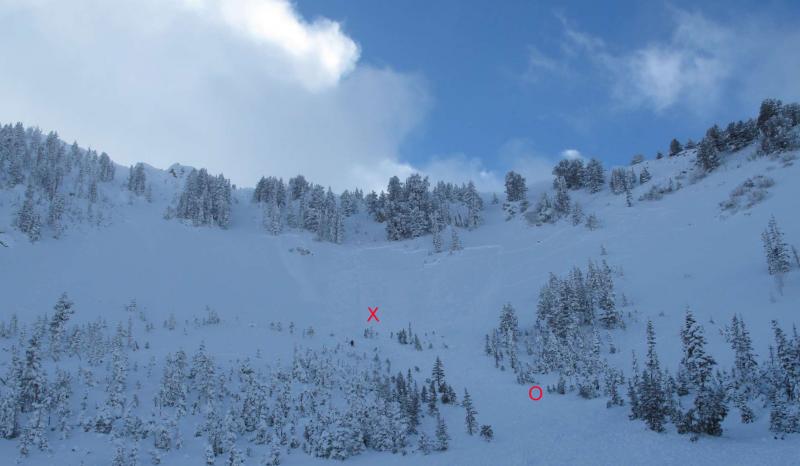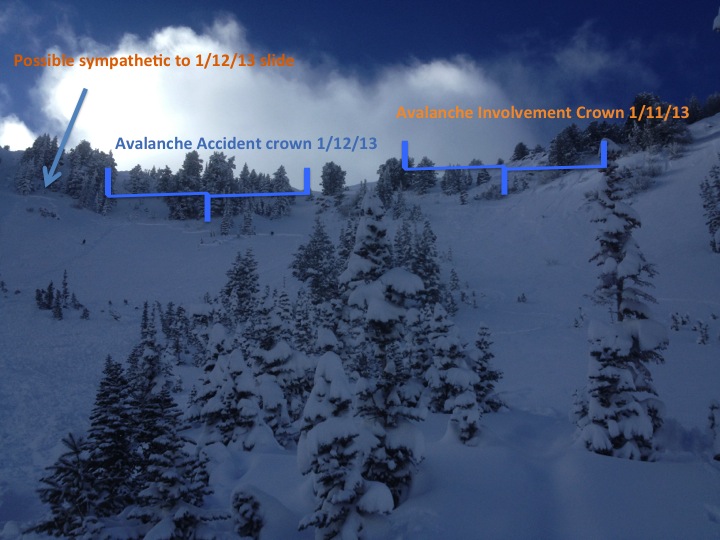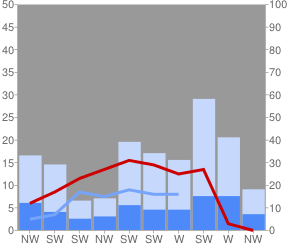Party's Comments:
We stood on top of the slope and discussed if we should ski the slope or not for several minutes. We chose a less steep line that we felt would be safe to ski. The first 2 skiers skied the slope and at the bottom stopped in a stand of trees in a safe zone. Both skiers commented on skiing the debris from a previous slide. The third skier dropped on in on the same line and about 1/3 of the way down the slope cut right off the debris. After descending 2/3 of the way down the slope, a powder cloud overtook the skier followed by the avalanche. The slide was remotely triggered (the skier was well downhill) and was a loose in nature but quickly grew in size, leaving a fairly substantial debris pile. The skier was able to initially grab onto a tree, but was eventually pulled off. The 2 skiers at the bottom saw both the slide and powder cloud approaching and immediately knew the slide was of decent size. The skiers called out for the caught skier. The skier caught was able to punch his hand through the snow and start calling for help. The 2 skiers below him immediately began ascending to the caught skier as he was only 100' above them. The 2 skiers on the top of the slope communicated to the bottom. The next dropped in, quickly made an assumption that the slope was safe, and arrived at the buried skier at the same time as the 2 skiers from below. The buried skier was able to dig his own head out so when the first 3 skiers arrived the skiers face was uncovered. We were able to quickly dig the rest of the buried skier out and by the time the final 2 skiers arrived (1 from the top and another skiing an adjacent line) we had the buried skier out. The skier lost his ski poles and other than a few scratches and bruises was uninjured.
An interesting note, the buried skier dropped into the slope with his Avalung in his mouth. After descending over 1/2 way down the slope and getting onto lower angle terrain, he removed the Avalung and was not able to get it back into his mouth once being carried by the slide.
When debriefing after the the day, we reviewed Ian McCammon's Heuristic Traps and didn't feel like we fell into any of the FACETS traps.
Party of 6 experienced backcountry skiers ascended the Bowman Trail out of Mill Creek to gain the north Gobbler's Knob ridgeline. They took a lap into the Yellowjacket trees. They noted one minor collapse and no shooting cracks. They were aware of the previous day's skier triggered avalanche 14" deep and 75' wide in Depth Hoar bowl into Alexander Basin.
Returning to the ridgeline, they decided to ski into Depth Hoar Bowl. They knew the danger was rated as Considerable for this slope; they knew the snowpack structure, and they knew of the previous day's slide. They were all good skiers and athletes and followed strict travel protocol (one at a time, getting out of the way at the bottom, and all agreed on the plan). The first skier dropped in to dig a hand pit and noted that there was only 6-8" of new snow above the early January facets and decided that if an avalanche occurred, it would be small. They also felt that the previous day's slide would make it safer; that is, they could find 'shelter' by skiing back into the previous bed surface/runout.
The first two skiers skiied without incident. The third, a 43 year old male, was half-way down the slope when he noticed a powder cloud engulfing him just before being overtaken by the debris. The remotely triggered slide broke perhaps 200' above him 1-2' deep and 125' wide and dragged him down the slope 200' before coming to a stop completely buried except for his hand and the top of his helmet. Skiers in his party above and below quickly reached him to assess the situation and ensure he had an airway. Other than a few bumps and bruises and lost ski poles, he was ok. Photo shows 'X' where skier was overtaken by the debris (actually a bit looker's left)...'O' where he was almost completely buried.



Depth Hoar Bowl is aptly named. It is a steep, cold, sheltered bowl in upper Alexander Basin that faces east to northeast with starting zones at 9300'-9800'. The snowpack there typically is thin and can often house a conditionally unstable snowpack. Many vegetative indicators often evidence of continuous avalanching; with perhaps a lone pine on a knoll in the runout zone devoid of any branches below 40' of its trunk.
Holiday storms from 12/24-28 brought significant snowfall to the Wasatch Range, with 42" storm total reported at Alta ski area for that time period. High pressure followed the storms, lasting through January 10. During that time, the snow surface became quite weak as the development of surface hoar and near surface faceting became widespread. Warm conditions, direct sun, and strong southwesterly winds eroded much of the weaknesses on the southerly aspects. Classic inverted temperatures developed more pronounced weaknesses at the mid and low elevations than the higher elevations. (Still, this may be splitting hairs...)
Strong southwesterly pre-frontal winds on Wednesday Jan 9th and Thursday Jan 10th signalled the arrival of a cold Pacific storm. By Thursday afternoon, snowfall began in earnest, and by Saturday morning, storm totals in the upper elevations totalled 14" with the valleys and mid-elevations receiving as much as 24"! Gusty southwesterly winds accompanied the storm early on. Charts below - left indicate no snow for the first week of January and the development of surface facets until the storm on the 10th. Chart on the right indicates winds spiking on the 9th/10th from the southwest that may have produced a thin wind slab prior to the storm.




Forecaster Comments: Very glad that things turned out ok for the skier who was caught by the avalanche. A couple of take home points -
- There had been a human triggered slide in the area the day before. They felt that they could head over toward that slide to use as an area of safety if a slide was triggered.
- The first skier did a hand pit and found only 6-8" of snow above the facets and felt that any avalanche would not be that big. Unfortunately this was not representative of the depth at the crown.
- The 1st two skiers skied the slope without incident.
- They found no cracking or significant collapsing on route.
- They were all excellent skiers/riders with a good deal of knowledge of snow and avalanche mechanics...but as the individual mostly buried confided to me - "We didn't see the forest for the trees. The big picture was that there was weak snow buried by a big storm on a steep avalanche prone slope with the danger as Considerable. What else is there to know?" I think he hits the nail on the head here. Sometimes our experience/education can give us a laundry list of reasons to ride a dangerous slope that we want to ride while ignoring the bull's eye clues.
Thanks for the write up gentlemen. Glad all's ok. Happens to the best of us.
Drew Hardesty
UAC Forecaster








